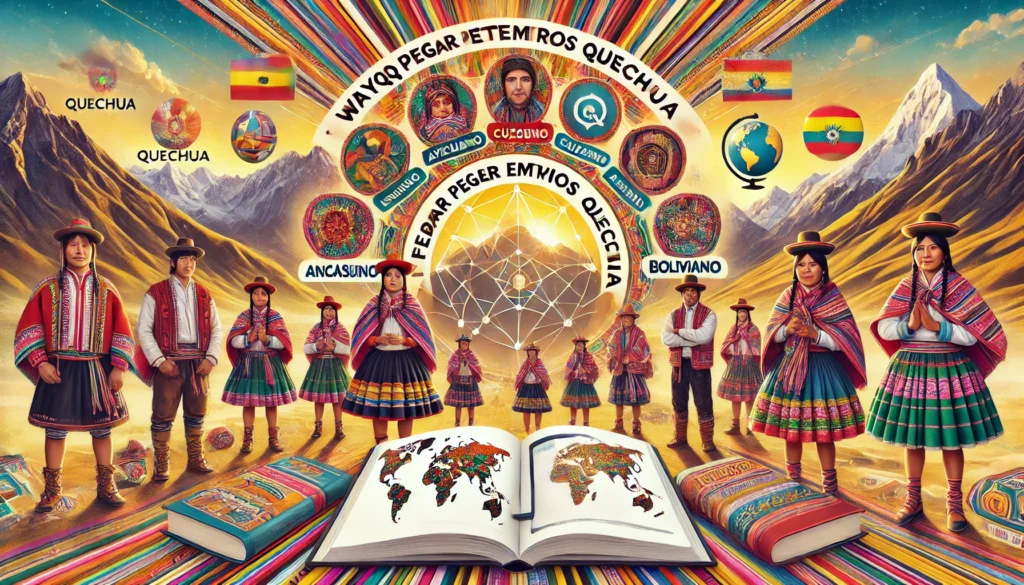The Quechua language, deeply rooted in the Andean region, represents one of the most culturally significant and widely spoken indigenous languages in South America. Spanning countries such as Peru, Bolivia, Ecuador, and parts of Colombia, Quechua is not a single language but a family of dialects, each reflecting the unique cultural and geographical influences of its region. The phrase “wayqear pegar entre varios quechua” encapsulates the complexity and effort involved in bridging the gaps between these diverse dialects, fostering unity and understanding across linguistic variations.
Understanding the Diversity of Quechua
Quechua’s diversity stems from its widespread use across vast terrains, from high-altitude mountain villages to bustling cities. Each region developed its unique dialect, leading to distinct linguistic variations. These dialects are often mutually unintelligible, making “wayqear pegar entre varios quechua” a metaphor for the challenge of connecting these linguistic strands.
Major Quechua Variants
- Quechua Ayacuchano
Spoken in the Ayacucho region of Peru, this variant is characterized by its simplified vowel system and unique phonetic traits. - Quechua Cuzqueño
Associated with the historic Inca capital of Cusco, this variant retains many traditional vocabulary elements and is often considered the “classical” form of Quechua. - Quechua Ancashino
Found in the Ancash region of northern Peru, this dialect reflects adaptations to geographical isolation, preserving distinct features. - Bolivian Quechua
Spoken across Bolivia, this variant incorporates influences from Spanish, reflecting centuries of cultural interaction.
These variations illustrate the linguistic richness of Quechua, but they also highlight the challenges encapsulated in “wayqear pegar entre varios quechua.”
Tools and Resources to Bridge Quechua Dialects
Efforts to unify and preserve Quechua have led to the development of numerous resources designed to facilitate understanding and communication among its variants. These tools are vital for learners, native speakers, and scholars alike.
1. Diccionario Quechua: Cochabamba Variant
Compiled by Joaquín Herrero and Federico Sánchez de Lozada, this comprehensive dictionary focuses on the Quechua spoken in Cochabamba, Bolivia. With over 16,300 entries, it provides deep insights into the semantics and cultural context of this regional dialect.
2. Illustrated Quechua–Spanish Dictionary
Created by Cerafina Condori, this dictionary is a beginner-friendly resource containing over 2,000 words. Its illustrations and examples make learning Quechua enjoyable and accessible.
3. QichwaDic Mobile Application
This app bridges multiple Quechua dialects by providing access to more than 20 dictionaries. Its offline functionality is especially useful for remote regions, making it an essential tool for navigating “wayqear pegar entre varios quechua.”
4. Diccionario Quechua: Junín-Huanca Variant
Compiled by Rodolfo Cerrón Palomino, this dictionary delves into the Huanca dialect, emphasizing its linguistic richness and cultural significance.
5. Quechua for Everyone: Chanka Dialect
Published by Tecnologías Dasbien, this resource focuses on the Quechua Chanka dialect. Its practical examples and contextual translations make it a valuable learning aid.
These resources demonstrate the growing efforts to address the complexities of “wayqear pegar entre varios quechua” by providing tools for learners and speakers to connect across dialects.
Preserving the Heritage of Quechua
Preservation of Quechua is essential for maintaining the cultural identity of Andean communities. Each dialect carries its unique history, traditions, and worldview. The idea of “wayqear pegar entre varios quechua” serves as a reminder of the need to respect and preserve this diversity.
Key Preservation Efforts
- Incorporating Quechua into Education
Teaching Quechua in schools ensures that younger generations understand and appreciate their linguistic heritage. - Promoting Digital Resources
Apps, online courses, and digital dictionaries make Quechua accessible to global audiences, breaking geographical barriers. - Cultural Revival Initiatives
Festivals, literature, music, and theater in Quechua help sustain its relevance and showcase its beauty. - Community Efforts
Local communities play a crucial role in keeping Quechua alive by using it in daily interactions, ceremonies, and storytelling.
Through these efforts, the challenge of “wayqear pegar entre varios quechua” becomes an opportunity to celebrate the rich tapestry of Quechua culture.
Challenges in Standardizing Quechua
Despite efforts to create a unified Quechua standard, the vast differences between dialects make this task challenging. While unified orthographies and linguistic frameworks have been developed, local variants often resist homogenization. This linguistic diversity, while enriching, also underscores the relevance of “wayqear pegar entre varios quechua” as a metaphor for the ongoing balancing act between unification and preserving individuality.
Why “Wayqear Pegar Entre Varios Quechua” Matters
The phrase “wayqear pegar entre varios quechua” highlights the importance of collaboration and mutual understanding among Quechua-speaking communities. It reflects the broader challenge of embracing diversity while striving for unity—a lesson that extends beyond language to culture and humanity as a whole.
By navigating these dialectical differences with respect and curiosity, Quechua speakers and learners can contribute to the preservation and growth of this invaluable linguistic heritage.
Frequently Asked Questions (FAQs)
1. What does “wayqear pegar entre varios quechua” mean?
This phrase refers to the effort and collaboration required to navigate and connect the various Quechua dialects, emphasizing mutual understanding and unity.
2. How many Quechua dialects exist?
There are numerous Quechua dialects, with major ones including Ayacuchano, Cuzqueño, Ancashino, and Boliviano. Each dialect reflects the cultural and geographical diversity of the Andean region.
3. What resources are available to learn Quechua?
Resources like the QichwaDic app, illustrated dictionaries, and regional Quechua dictionaries provide valuable tools for learning and exploring the language.
4. Why is preserving Quechua important?
Preserving Quechua ensures the survival of Andean cultural identity, traditions, and linguistic diversity, which are integral to understanding the region’s history and heritage.
5. How can “wayqear pegar entre varios quechua” inspire collaboration?
The phrase reminds us of the importance of working together to embrace diversity, whether in language, culture, or other aspects of life, fostering unity through mutual respect.
